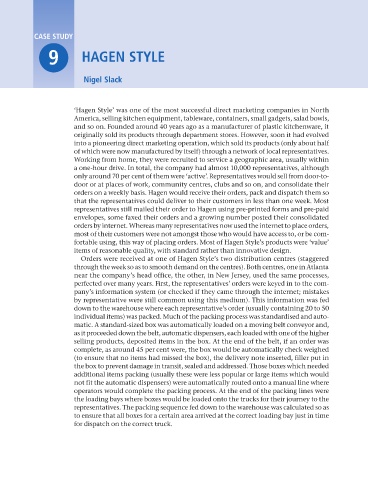Page 439 - Operations Strategy
P. 439
Case study
9 Hagen style
nigel slack
‘Hagen Style’ was one of the most successful direct marketing companies in North
America, selling kitchen equipment, tableware, containers, small gadgets, salad bowls,
and so on. Founded around 40 years ago as a manufacturer of plastic kitchenware, it
originally sold its products through department stores. However, soon it had evolved
into a pioneering direct marketing operation, which sold its products (only about half
of which were now manufactured by itself) through a network of local representatives.
Working from home, they were recruited to service a geographic area, usually within
a one-hour drive. In total, the company had almost 10,000 representatives, although
only around 70 per cent of them were ‘active’. Representatives would sell from door-to-
door or at places of work, community centres, clubs and so on, and consolidate their
orders on a weekly basis. Hagen would receive their orders, pack and dispatch them so
that the representatives could deliver to their customers in less than one week. Most
representatives still mailed their order to Hagen using pre-printed forms and pre-paid
envelopes, some faxed their orders and a growing number posted their consolidated
orders by internet. Whereas many representatives now used the internet to place orders,
most of their customers were not amongst those who would have access to, or be com-
fortable using, this way of placing orders. Most of Hagen Style’s products were ‘value’
items of reasonable quality, with standard rather than innovative design.
Orders were received at one of Hagen Style’s two distribution centres (staggered
through the week so as to smooth demand on the centres). Both centres, one in Atlanta
near the company’s head office, the other, in New Jersey, used the same processes,
perfected over many years. First, the representatives’ orders were keyed in to the com-
pany’s information system (or checked if they came through the internet; mistakes
by representative were still common using this medium). This information was fed
down to the warehouse where each representative’s order (usually containing 20 to 50
individual items) was packed. Much of the packing process was standardised and auto-
matic. A standard-sized box was automatically loaded on a moving belt conveyor and,
as it proceeded down the belt, automatic dispensers, each loaded with one of the higher
selling products, deposited items in the box. At the end of the belt, if an order was
complete, as around 45 per cent were, the box would be automatically check weighed
(to ensure that no items had missed the box), the delivery note inserted, filler put in
the box to prevent damage in transit, sealed and addressed. Those boxes which needed
additional items packing (usually these were less popular or large items which would
not fit the automatic dispensers) were automatically routed onto a manual line where
operators would complete the packing process. At the end of the packing lines were
the loading bays where boxes would be loaded onto the trucks for their journey to the
representatives. The packing sequence fed down to the warehouse was calculated so as
to ensure that all boxes for a certain area arrived at the correct loading bay just in time
for dispatch on the correct truck.
Z09 Operations Strategy 62492.indd 414 02/03/2017 13:54

